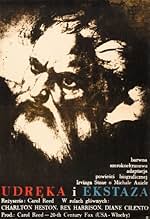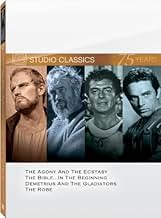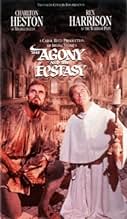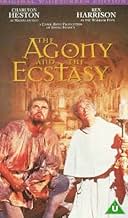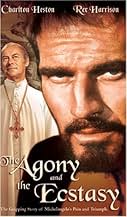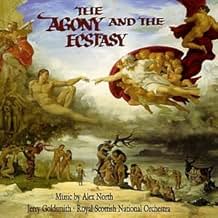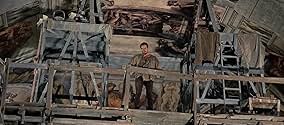Michelangelo - Inferno und Ekstase
Originaltitel: The Agony and the Ecstasy
IMDb-BEWERTUNG
7,2/10
8577
IHRE BEWERTUNG
Die biografische Geschichte von Michelangelos Schwierigkeiten bei der Ausmalung der Sixtinischen Kapelle auf Drängen von Papst Julius II.Die biografische Geschichte von Michelangelos Schwierigkeiten bei der Ausmalung der Sixtinischen Kapelle auf Drängen von Papst Julius II.Die biografische Geschichte von Michelangelos Schwierigkeiten bei der Ausmalung der Sixtinischen Kapelle auf Drängen von Papst Julius II.
- Regie
- Drehbuch
- Hauptbesetzung
- Für 5 Oscars nominiert
- 3 Gewinne & 9 Nominierungen insgesamt
Fortunato Arena
- Pope's Bodyguard
- (Nicht genannt)
Lars Bloch
- Baron Von Silenen
- (Nicht genannt)
Angelo Boscariol
- Papal Guard
- (Nicht genannt)
Calisto Calisti
- Physician
- (Nicht genannt)
Amerigo Castrighella
- Quarry cart assistant
- (Nicht genannt)
Anita Ceccotti
- Woman Under the Chapel
- (Nicht genannt)
Enrico Chiappafreddo
- Tavern Customer
- (Nicht genannt)
Empfohlene Bewertungen
like many historical films from the same age of Hollywood, the word "impressive" is the first to say. not only for its status of epic drama, costumes and the translation in image of a period. but, maybe , more important, for the admirable clash between Rex Harrison and Charlton Heston. and for the feel than a great story has its right and fair adaptation. because something impose "The Agony and the Ectasy" as special. not the biography of a great artist - and the admirable virtue is to know than Heston is Michelangelo not only act him - but the chance to discover yourself. the film, like the book, it is a beautiful eulogy to the life. using a genius as character of a kind of parable about art, proud, honesty and desire. so, just impressive. in this case - a word with deep roots.
I like historical films. Recently I watched three historical films all made in the early 1960s. These are 'El Cid', 'The Spartacus' and 'The Agony and The Ecstasy'. Of the three, I rate The Agony and the Ecstasy as the best. This film is based on the eponymous novel written by Irving Stone. I had read the book nearly a decade back and it was nice to see the film finally. The film is about the circumstances under which Michelangelo came to compose his famous frescoes in the Sistine Chapel of Rome in the 16th century. The Sistine fresco, the 'creation of man' has become almost an emblem for the artist. But not many know that Michelangelo painted the Sistine frescoes reluctantly, only because he was forced to do so by his patron, Pope Julius II. The film is about the war of wits between these two great men Pope Julius II is a warrior pope, a worldly Pope. His concern is to protect the papal states from being over run by warring European powers. For this he is willing to take up arms. The pope knows that the posterity wont remember him for his spiritual prowess or leadership. Therefore he want to leave great works of art as his legacy. He therefore hires Michelangelo to paint the ceiling of the Sistine Chapel. The artist is not very keen on painting and considers sculpture to be his true calling. He is also not willing to conform to the prevailing canons of artistic excellence. He feels constrained by the limits of time and money that is set. All the great moments of the film occur when the Pope and the Artist clash. It is a clash of ideas and world views: (1) Whether sculpture is a superior form of art as compared to painting; (2) Whether it is appropriate depict biblical figures in their raw humanity; (3) Whether it is moral for a man of god to take arms for his principles and so on. For me the finest scene in the film is where the Pope and the Cardinals come to see the frescoes and judge it as lacking in good taste. The Artist is forced to give a strong rebuttal and in the process he expounds the humanist philosophy of art. Shot in beautiful Technicolor, the film still looks spectacular. It is a visual and intellectual treat.
"The Agony and the Ecstasy" is the story of Michaelangelo and his painting of the Sistine Chapel at the behest of Pope Julius II, a warrior and Patron of the Arts.
But it's really about so much more - the connection between art and the artist, faith, will, and the quest for perfection. Most of all, it's about the complicated relationship of two determined men, Michaelangelo and Pope Julius, which is adversarial and even violent.
The color and scenery in this film are truly beautiful, but I'd love to see a restored print, as I imagine the colors would even be richer.
Charlton Heston is a convincing and strong Michelangelo in what may be his best performance. It's buoyed by the magnificent work of Rex Harrison as Julius II. The two spark one another, and the result is an exciting screen teaming. There is hatred, resentment, a battle of wills, love and admiration between them, the agony and ecstasy of connecting with another, as Diane Cilento says in the film. She plays a woman in love with Michaelangelo. He explains that he cannot love her because of the commitment he has made to his true love, his art. The book hints at Michaelangelo's homosexuality, and it's covered with one line. After Michaelangelo says that he cannot match her feelings, he looks at a sketch of a nude man. "And it's not that either," he says.
Many scenes stick out. The somewhat hokey one in the mountains, when Michaelangelo looks at the heavens and receives his inspiration is nevertheless a gorgeous scene; the incredible scene when Michaelangelo discovers the Pope alone at night with a candle studying the ceiling is perhaps the best, as Michaelangelo explains his concept of God and faith. And the last scene between the two men is unforgettable.
There is a documentary about Michaelangelo and his work before the movie begins. A magnificent film. Don't miss it.
But it's really about so much more - the connection between art and the artist, faith, will, and the quest for perfection. Most of all, it's about the complicated relationship of two determined men, Michaelangelo and Pope Julius, which is adversarial and even violent.
The color and scenery in this film are truly beautiful, but I'd love to see a restored print, as I imagine the colors would even be richer.
Charlton Heston is a convincing and strong Michelangelo in what may be his best performance. It's buoyed by the magnificent work of Rex Harrison as Julius II. The two spark one another, and the result is an exciting screen teaming. There is hatred, resentment, a battle of wills, love and admiration between them, the agony and ecstasy of connecting with another, as Diane Cilento says in the film. She plays a woman in love with Michaelangelo. He explains that he cannot love her because of the commitment he has made to his true love, his art. The book hints at Michaelangelo's homosexuality, and it's covered with one line. After Michaelangelo says that he cannot match her feelings, he looks at a sketch of a nude man. "And it's not that either," he says.
Many scenes stick out. The somewhat hokey one in the mountains, when Michaelangelo looks at the heavens and receives his inspiration is nevertheless a gorgeous scene; the incredible scene when Michaelangelo discovers the Pope alone at night with a candle studying the ceiling is perhaps the best, as Michaelangelo explains his concept of God and faith. And the last scene between the two men is unforgettable.
There is a documentary about Michaelangelo and his work before the movie begins. A magnificent film. Don't miss it.
'Agony and the Ecstasy' is one heck of an attempt to be a big of a movie as possible. It's details the story of Pope Julius's commissioning of a reluctant Michelangelo to paint the roof of the Sistine chapel fer heaven's sakes!! It also two of the stars That Mattered In The 60's, Rex Harrison playing the Pope and Charlton Heston as Michelangelo! AND it runs for 2 and a half hours! I mean, this movie must mean something if they have a mini-biography of Michelangelo for the first 15 minutes, right? OK, despite it's too long running length, the movie is a fun sit through actually. It's not exactly a pompous costumed historical drama as it looks, sure there's a lot material covered here, but Heston and Harrison keep the story going quite well with their great portrayals here. I had seen this several years ago, and while Heston is good, it's Harrison who got my attention this time out, as his total control freak Pope character is quite entertaining to watch.
So again, a bit lengthy, but still entertaining.
So again, a bit lengthy, but still entertaining.
The picture deals with Michelangelo or Michael Angel (Charlton Heston) who is working on the Carrara's marble creating sculptures and he is then ordered by Pope Julius II (Rex Harrison) the painting of as called Sistine chapel (that's why it was built by Pope Sisto) . Meanwhile , they'll develop various relationships with other Renaissance's important people . The film is correctly based on historical deeds and appearing famous roles , such as : Raphael (Tomas Milian) who shows up painting the ¨Athenas' school¨, Bramante (Harry Andrews) builder of the Vatican dome that hold his name , Girlandaio , Florence Medicis' descendants (Diane Cilento and Adolfo Celi) and duke of Urbin (Alberto Lupo). Besides , the film paces itself the confrontation between Julius II troops and the French/German army for the possession of the Pope's states . There are epic and impressive battles where the Pope himself fights enemies . The motion picture describes specially the creation of the enormous paintings on the ceiling and the difficulties that Michael Angel is suffering to achieve the immortal legacy . The Pope Julio II will also assign him the realization of his tomb .
The feature movie obtained a limited success and had a moderated box-office ; however , being nowadays better valued than the past . First-range acting by the two main actors : Charlton Heston and Rex Harrison , both of whom are magnificent . However , Rex Harrison did not get along with Charlton Heston at all during shooting ; in fact , twelve years later, while filming as secondary actors ¨Crossed swords¨ (1977) directed by Richard Fleischer , Rex avoided him utterly . Leon Shamroy's cinematography is rousing , the colorful paintings are glowing and brilliant ; spectacularly showing Bible's scenes at the Sistine Chapel . Alex North musical score is riveting (like ¨Spartacus¨ who he equally composed) . The sets are overwhelming and breathtaking , they were stunningly designed by production designer John De Cuir . In addition , evocative as well as adequate costumes by Oscarized Vittorio Nino Novarese . Carol Reed production and direction were excellent , he'd got much experience through a long career and had directed other classic movies (The third man) . Rating: Very good , above average and well worth seeing.
The feature movie obtained a limited success and had a moderated box-office ; however , being nowadays better valued than the past . First-range acting by the two main actors : Charlton Heston and Rex Harrison , both of whom are magnificent . However , Rex Harrison did not get along with Charlton Heston at all during shooting ; in fact , twelve years later, while filming as secondary actors ¨Crossed swords¨ (1977) directed by Richard Fleischer , Rex avoided him utterly . Leon Shamroy's cinematography is rousing , the colorful paintings are glowing and brilliant ; spectacularly showing Bible's scenes at the Sistine Chapel . Alex North musical score is riveting (like ¨Spartacus¨ who he equally composed) . The sets are overwhelming and breathtaking , they were stunningly designed by production designer John De Cuir . In addition , evocative as well as adequate costumes by Oscarized Vittorio Nino Novarese . Carol Reed production and direction were excellent , he'd got much experience through a long career and had directed other classic movies (The third man) . Rating: Very good , above average and well worth seeing.
Wusstest du schon
- WissenswertesThe book on which this movie is based covers the entire life of Michelangelo Buonarroti. This movie based on a single chapter. One of the shortest, if not the shortest, in the entire book.
- PatzerAs shown in the movie, Michelangelo created a flat wooden platform on brackets built out from holes in the wall, high up near the top of the windows. But contrary to what is depicted in the film, he did not lie on this scaffolding while he painted, but painted from a standing position.
- VerbindungenEdited from Prologue: The Artist Who Did Not Want to Paint (1965)
Top-Auswahl
Melde dich zum Bewerten an und greife auf die Watchlist für personalisierte Empfehlungen zu.
- How long is The Agony and the Ecstasy?Powered by Alexa
Details
- Erscheinungsdatum
- Herkunftsland
- Sprachen
- Auch bekannt als
- La agonía y el éxtasis
- Drehorte
- Piazza del Popolo, Todi, Perugia, Umbria, Italien(St. Peter's Square scene)
- Produktionsfirma
- Weitere beteiligte Unternehmen bei IMDbPro anzeigen
Box Office
- Budget
- 10.000.000 $ (geschätzt)
- Laufzeit
- 2 Std. 18 Min.(138 min)
- Farbe
- Seitenverhältnis
- 2.20 : 1
Zu dieser Seite beitragen
Bearbeitung vorschlagen oder fehlenden Inhalt hinzufügen


